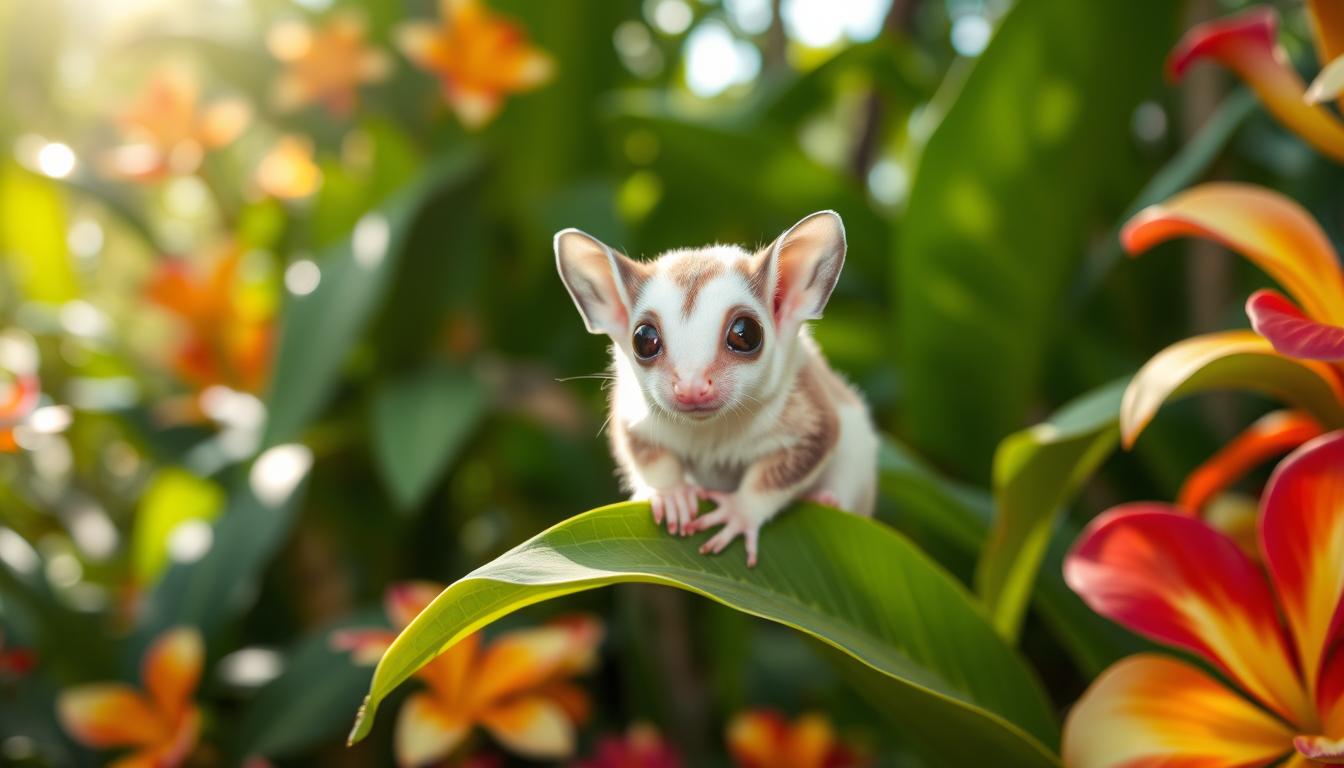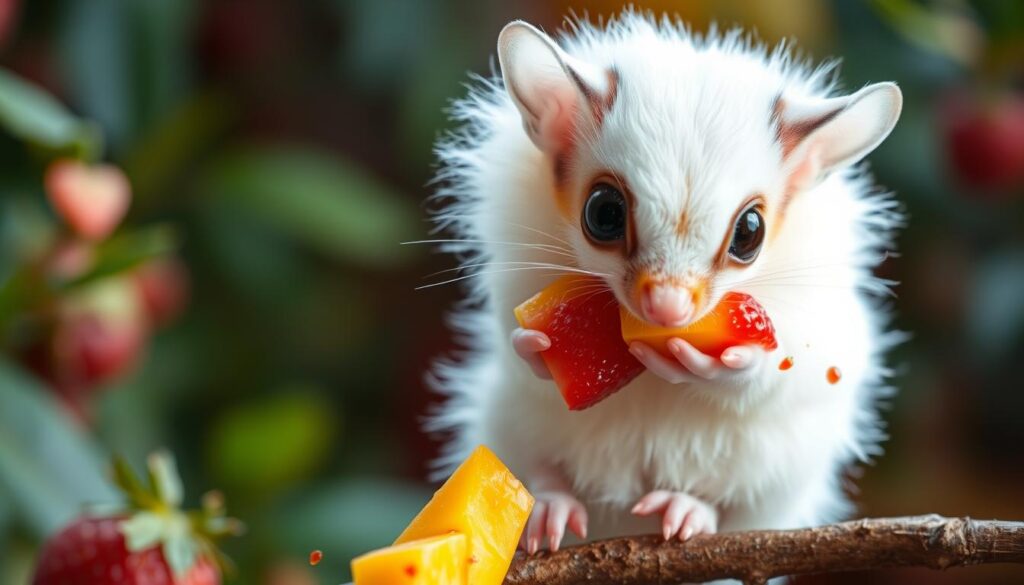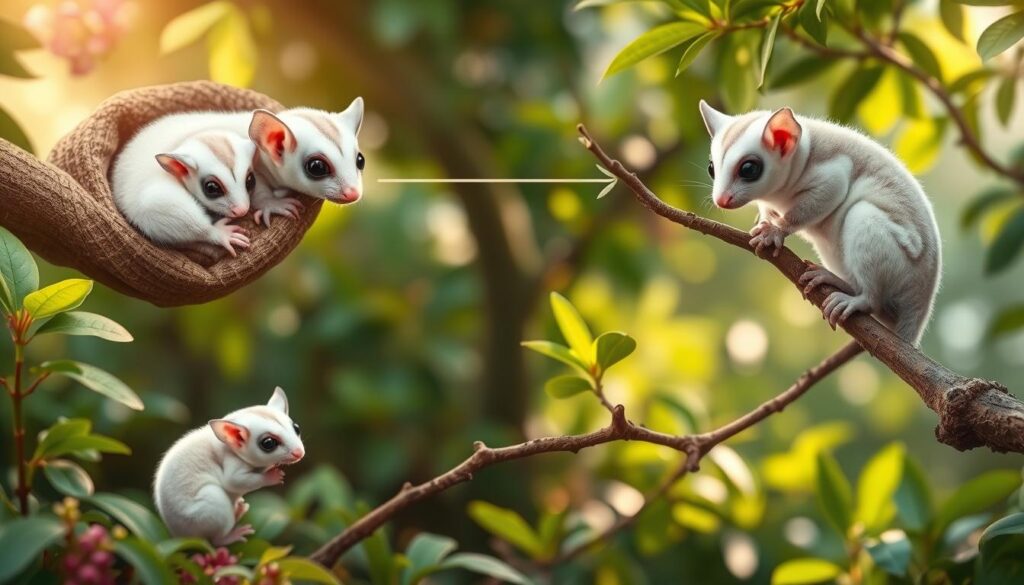White Sugar Glider: Adorable Exotic Pet Guide

Did you know a white sugar glider can live with you for 10-15 years1? This guide will show you how to welcome a white sugar glider into your life. They are marsupials that need care, the right food, and a cozy home to be happy.
Key Takeaways
- White sugar gliders make great pets with the right care and attention.
- It’s important to know their needs, like a big enough enclosure of at least 120 cm in height1.
- They need a balanced diet with 20-30% protein and the right calcium and phosphorus1.
- Discovering the white variety, with its unique look, makes owning a pet more fun2.
- Knowing the laws and ethics of exotic pets, like sugar gliders, helps you be a responsible owner.
- With the right care, these pets can bring joy and energy to your home for years.
Understanding the Unique Nature of the White Sugar Glider
The white sugar glider is a fascinating exotic pet, loved for its unique look and lively behavior. They come from the treetops of Australia, Papua, and Indonesia. Their home is like eucalyptus forests, where they play at night.
The Origin and Natural Habitat
Their natural home is key to their life. It’s dense, forested areas that help them survive. These places are perfect for their tree-dwelling lifestyle, offering food and high trees for gliding.
In the wild, they can glide up to 45 meters to find food or avoid danger3.
Distinct Physical Characteristics and Behavior
White sugar gliders come in many colors and patterns. Each one, like Albino to Ruby Leu, shows the variety of these pets. For example, True Platinum Mosaics are a special part of their color range4.
They live in groups, with up to 40 members. These groups have a leader, showing their complex social life3. They are also known for their gliding, which lets them move fast through their habitat.
Knowing about their habitat, social life, and looks helps us see why they’re so special as pets.
Legal Considerations and Ethical Responsibilities of Owning Exotic Pets
Thinking about getting a white sugar glider as a pet? It’s key to know the legal considerations and ethics involved. Owning an exotic pet is more than just love and commitment. It means understanding the laws and rules that apply.
State-by-State Exotic Pet Regulations in the U.S.
Rules for owning exotic pets, like white sugar gliders, change a lot from state to state. Some places, like California and Georgia, don’t let you have sugar gliders. Others might need you to get special permits5. Knowing your state’s rules is important to follow the law and avoid trouble. Check out the detailed guide on sugar gliders as pets for more info.
The Ethical Debate: Sugar Gliders in Domesticity
There’s a big debate about whether sugar gliders should be pets. Some say homes can’t provide what they need, leading to stress and health issues5. Others believe the bond between sugar gliders and their owners is strong, and the care they receive is better than in the wild.
Ethical responsibilities mean giving your white sugar glider the right care, socialization, and home. This can help avoid health problems like malnutrition and behavioral issues5. Angels Pet World has lots of resources to help you create a great home for them.
While the charm of having an exotic pet like a white sugar glider is strong, it requires a deep commitment. You must understand the legal considerations and ethical standards of being a responsible pet owner.
Creating a Comfortable Habitat for Your White Sugar Glider
To make sure your white sugar glider is happy in captivity, you need to create a perfect home for them. This means setting up an enclosure that feels like their natural habitat. You also need to keep the temperature, lighting, and safety just right for these special animals.
Essentials of Safe and Spacious Enclosures
The cage for your white sugar glider should be big enough for them to glide and climb. It’s best to have a cage that’s at least 3 feet high and 2 feet wide. The bars should be no more than 1/2 inch apart to prevent them from getting hurt or escaping6.
It’s also good to keep them with friends. This makes them happier and healthier6.
Temperature, Lighting, and Safety Factors in Cage Placement
White sugar gliders don’t like it too hot or too cold. They need a temperature between 75-80°F to feel comfortable7. Make sure the cage is not in direct sunlight or drafty places. This keeps them safe from getting too hot or sick.
It’s important to make sure the cage is safe. Keep it away from things that could hurt them, like open water or harmful materials in bedding or toys.
Make sure the cage has toys and places to climb. This keeps them active and happy. Use safe toys and bedding to keep them healthy8. Clean the cage, toys, and bedding often to keep them disease-free and clean6.
Here’s a helpful table summarizing the basic requirements for a safe and enriching white sugar glider habitat:
| Feature | Importance | Details |
|---|---|---|
| Enclosure Size | Critical | Minimum 3′ x 2′ for a pair6 |
| Bar Spacing | Essential | No more than 1/2 inch |
| Temperature Control | Vital | 75-80°F7 |
| Lighting | Important | Avoid direct sunlight and maintain low-level lighting during the day |
| Toys and Structures | Important | Non-toxic materials only, include climbing structures and safe toys8 |
| Cleaning Routine | Crucial | Frequent cleaning of cage, bedding, and toys for hygiene6 |
By thinking about everything from the size of the cage to fun activities, you can make a great home for your white sugar glider. Being a good pet owner means following these tips to keep your glider healthy, happy, and long-lived.
Nurturing Through Diet: What White Sugar Gliders Eat

As an exotic pet owner, knowing what white sugar gliders eat is key to their health and happiness. A balanced diet that meets their needs is crucial for their well-being.
Commercial Diets and Homemade Nutritional Plans
White sugar gliders need a diet rich in fruits, vegetables, and proteins. Their diet should be about 75% fruits and veggies and 25% protein9. The Australian Wombaroo diet is a favorite, as it closely matches their natural diet.
Adding supplements like reptile multivitamins or calcium with D3 is also important9. These help fill any nutritional gaps and support their health.
Treats and Foods to Avoid for Optimal Health
While sugar gliders enjoy many fruits and veggies, some foods are bad for them. Avoid giving them raw sugar, sugar substitutes, candy, or chocolate9. Stick to safe fruits and veggies to keep them healthy and active.
Make sure they always have fresh water, as they get most of their water from their food9. This is important for staying hydrated and digesting food well.
| Food Type | Recommended | To Avoid |
|---|---|---|
| Fruits and Vegetables | Apples, Papaya, Carrots | Onions, Garlic, Avocado |
| Proteins | Cooked lean meats, Boiled eggs | Raw meat, High-fat meats |
| Treats | Dried insects, Honey | Candy, Chocolate |
For more on pet care and nutrition, check out this guide on Toy Fox Terriers. It also talks about the importance of a tailored diet.
White Sugar Glider Social Dynamics and Bonding with Your White Sugar Glider
Understanding the complex social dynamics of the white sugar glider is key for pet owners. These cute animals love to be around others to stay happy and healthy. Studies show that sugar glider groups can have up to 40 adults, with two alpha males leading and mostly raising the young10.
Keeping your sugar gliders in groups of three or more is important. This helps them feel like they belong in a community. It’s also vital to focus on their social needs and health in your care10.
| Age | Bonding Behavior | Care Needs |
|---|---|---|
| Young | May not greet at cage door as adults do | Intense bonding sessions and socialization |
| Adult | Better at handling dietary experiments with Greek yogurt | Regular health checks, social interaction |
Bonding with your sugar glider takes time and effort. Regular handling and play builds trust and a strong bond. Also, neutering males over 4 months helps with group harmony10.
Knowing how to care for your sugar gliders is essential. For example, having equal numbers of males and females keeps the group balanced10. Regular interaction keeps them happy and mentally healthy, showing the importance of companionship.
Learning about white sugar glider social behaviors helps you care for them better. Whether you’re new or experienced, these tips can make a big difference in your glider’s life.
The bond you form with your sugar glider is special and rewarding. They are known for their deep connections and loyalty. Treating them with kindness and respect brings them joy and affection.
Keeping Your Pet Active: Entertainment and Exercise
Keeping your white sugar glider active and entertained is key for their health. These pets need both physical and mental stimulation. They are most active at night, from sundown to sun-up11. We’ll look at ways to keep your pet happy and active.
Recommended Toys and Play Structures
Your pet’s play area should have a variety of toys. Items like ropes, wheels without axles, and climbing branches are great. They mimic the natural environment and provide exercise. Sugar Gliders can get bored without the right toys, making their environment very important11.
Choose toys and structures that encourage climbing and gliding. This is perfect for a night-active pet12.
Creating Enriching Experiences for Mental Stimulation
Enrichment goes beyond physical structures. Adding eucalyptus branches and foraging toys stimulates their senses. These help recreate wild experiences. Regular interaction with humans also enriches their lives, preventing loneliness11.
Carrying them in a shirt pocket or bonding pouch builds trust and security. This is crucial for their social interactions12.
Adding these activities to your pet’s daily routine keeps them active and healthy. It also makes their environment joyful and stimulating.
Health Concerns and Preventive Care Tips for White Sugar Gliders
Thinking about getting a white sugar glider as a pet? It’s key to know about their health concerns for good preventive care. These cute animals can get sick if not taken care of right away.
Common Health Issues and Symptoms to Watch For
Dental disease is a big problem for white sugar gliders because of their sweet diet. This can cause tooth decay, gum problems, and even tooth removal13. Look for signs like swollen eyes and abscessed teeth. These might need cleaning and antibiotics13.
They can also get diarrhea from bad diets or infections. This can make them lose a lot of weight and get dehydrated, needing vet help fast13.
Hypocalcemia, or low blood calcium, is another issue. It can make them thin, shaky, and not want to eat. They might need a special diet or supplements13. Being too fat is also a problem, leading to serious health issues like liver and heart disease13.
Routine Health Check-ups and Dental Hygiene
Regular vet visits are important for your sugar glider’s health. They help catch problems early and make sure they’re eating right. A vet who knows about exotic pets should check their teeth14.
Good oral care is crucial because sugar gliders easily get dental problems from their diet13. Keep their home clean and fun to prevent stress. They need friends to stay happy and healthy14.
By taking care of your sugar glider, you can ensure they live a long, happy life. They will be a wonderful companion for many years.
The Lifespan of White Sugar Gliders and Long-Term Care Needs

White sugar gliders bring joy and a big responsibility. Knowing how long they live and their care needs is key for owners. This is true for both new and current owners of these exotic pets.
Understanding Natural Lifespan in Captivity
White sugar gliders can live up to 15 years in captivity15. This long life shows the need for a long-term care plan. Their night habits mean special care for their home and social life1615.
Ensuring Quality of Life as Your Pet Ages
As your sugar glider gets older, their home needs to change. This includes better food, cleaner living space, and more social time. Regular vet visits can stop common problems like infections and dental issues15.
Good care means daily play and a safe, interesting home. This keeps them healthy and happy. You might need to make changes as they get older, like easier food or a safer home.
Here’s a table with important care tips for your sugar glider:
| Aspect | Consideration | Frequency |
|---|---|---|
| Health Check-ups | Monitor for parasites, injuries, and dental health | Annually or Bi-annually |
| Diet Modification | Adjust based on age-related health needs | As required |
| Social Interaction | Ensure daily interaction and companionship | Daily |
| Habitat Maintenance | Adapt enclosure for easy access and safety | Every 2 to 4 weeks16 |
Guidance for exotic pets like sugar gliders is crucial. It helps them live a happy, healthy life. Following these tips will make your pet’s life better.
Conclusion
If you’re thinking about getting a white sugar glider as a pet, you’re not alone. These marsupials are amazing, gliding through the air with ease. They can cover over 150 feet in one go17.
They need special care, which is key to a happy relationship. It’s important to provide a good home and the right food. This way, you can enjoy their playful and loving nature.
Sugar gliders love to be in groups, often living in colonies of up to seven. They need a big space to live and play together. It’s also crucial to know about the different types of sugar gliders, with 7 varieties found in Australia and New Guinea17.
Being a good pet owner means understanding that sugar gliders are more than pets. They are not just trendy because of their color. It’s important to see beyond the color and focus on their health and happiness18.
By learning more about white sugar gliders, you can start a rewarding journey. You’ll learn about their unique needs and how to care for them. Remember, owning a sugar glider is allowed in most U.S. states17.
To learn more, check out the sugar glider world. It’s full of interesting facts about their behavior and care.
FAQ
What specific care does a white sugar glider require?
Can you legally own a white sugar glider in every state?
What does a white sugar glider’s diet consist of?
Are sugar gliders social animals?
How can I keep my white sugar glider entertained and healthy?
What health issues should I be aware of with a white sugar glider?
How long can a white sugar glider live in captivity?
What should I consider before buying a white sugar glider?
Source Links
- https://pawpals.ae/blog/keeping-sugar-gliders-as-pets-a-beginners-guide – Keeping Sugar Gliders as Pets – A Beginner’s Guide | Paw Pals
- https://exoticnutrition.com/blogs/blog/the-diverse-colors-of-sugar-gliders?srsltid=AfmBOop5Mg3YXo0uxZQXczE2-XMdKdo3QXZWBbWhqMx3_LIahel9JVQZ – The Diverse Colors of Sugar Gliders
- https://seaworld.org/animals/facts/mammals/sugar-glider/ – Sugar Glider Facts and Information
- https://exoticnutrition.com/blogs/blog/the-diverse-colors-of-sugar-gliders?srsltid=AfmBOoqmOfWfgVrsBFG9N6hGqBmWTLLoU3dWwmJddopKeCGo30pRqrTT – The Diverse Colors of Sugar Gliders
- https://www.ncbi.nlm.nih.gov/pmc/articles/PMC8096126/ – Exotic pets in Ireland: 2. Provision of veterinary services and perspectives of veterinary professionals’ on responsible ownership
- https://www.wikihow.com/Care-for-a-Sugar-Glider – How to Care for a Sugar Glider (with Pictures) – wikiHow
- https://catandexoticcare.com/?p=952 – Sugar Gliders – Cat and Exotic Care
- https://www.tortoisetown.com/sugar-glider-habitat/ – Sugar Glider Habitat
- https://www.vetcarepethospital.ca/beginners-guide-sugar-glider-care/ – Beginner’s Guide to Sugar Glider Care – VetCare Pet Hospital
- https://cutesugarglider.com/sugar-glider-colony/ – Sugar Glider Colony – Cutesugarglider.com
- https://www.mylittlesugarglider.com/basic-care/ – Basic Care | My Little Sugar Glider
- https://www.jandaexotics.com/post/sugar-glider-in-depth-pet-care – Owning a Sugar Glider Complete Pet Care Guide basics and advanced care
- https://vcahospitals.com/know-your-pet/sugar-gliders-common-diseases – Sugar Gliders Common Diseases | VCA Animal Hospitals
- https://www.northgateveterinary.com/site/blog/2022/05/30/caring-for-sugar-gliders – Northgate Veterinary Clinic
- https://www.thesprucepets.com/sugar-glider-facts-1237340 – Check out These Facts About Sugar Gliders as Pets
- https://broomfieldvet.com/pros-and-cons-of-having-a-pet-sugar-glider/ – The Pros and Cons of Having a Pet Sugar Glider – Broomfield Veterinary Hospital
- https://www.activewild.com/sugar-glider-facts/ – Sugar Glider Facts For Kids: Information With Pictures & Video
- https://sugar-gliders.com/diabetics-smell-like-fruit-a-tale-of-two-sugar-glider-colors/ – Diabetics Smell Like Fruit, A Tale of Two Sugar Glider Colors – Suncoast Sugar Gliders


